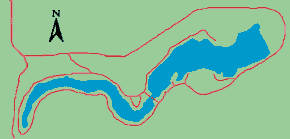Fishing
- Licenses & Regulations
- ShareLunkers
- Fish Identification
- Fish Consumption
- Texas Freshwater Fisheries Center
Water Resources
- Texas Reservoir Levels
- US Army Corps of Engineers
- Texas Water Issues
- Golden Alga
- Aquatic Vegetation
PO
Box 835
Canyon, Texas 79015
(806) 655-4341
Caleb Huber, Biologist
Local Information
Buffalo Springs Lake
Quick Links: Fishing Regulations | Angling Opportunities | Cover & Structure | Tips & Tactics
Lake Characteristics
Location: 5 miles east of Lubbock on the
North Fork of the Double Mountain Fork of the Brazos River
Surface area: 241
Maximum depth: 52 ft., mean depth
15 ft.
Impounded: 1960
Water Conditions
Fluctuation: Mild, less than
1 foot
Normal Clarity: Stained, 1-2 feet
visibility
Reservoir Controlling Authority
Lubbock County WC&ID No. 1
9999 High Meadow Road
Lubbock, Texas 79404
(806) 747-3353
Aquatic Vegetation
Limited to stands of cattail located around the reservoir
Predominant Fish Species
Lake Records
Stocking History
Latest Survey Report
Lake Maps
Lubbock County and Lubbock City maps provide a general view of the lake area.
Fishing Regulations
All species are currently managed under statewide regulations.
Angling Opportunities
| Species | Poor | Fair | Good | Excellent |
|---|---|---|---|---|
| Largemouth Bass | ||||
| Flathead Catfish | ||||
| Channel Catfish | ||||
| Crappie | ||||
| Striped Bass | ||||
| White Bass | ||||
| Sunfish |
Fishing Cover/Structure
Working with local partners, TPWD has installed a variety of man-made fish habitat structures in this reservoir. Anglers may use GPS in conjunction with a fish finder to locate these structures.
Use the Habitat Structure Viewer for an interactive map of fish habitat structures and downloadable GPS coordinates.
Tips & Tactics
The reservoir has a dense population of gizzard shad, which is the primary prey for largemouth bass. Your presentation must compete with this natural food base, so accurate casts and a sensitive touch are needed. Try pitching plastic worms into holes in the cattails or floating worms along structure in the mornings. Suspending baits are a good option for keeping your bait in the strike zone longer. Stripers can be caught by downrigging 4-inch white plastic grubs or with live bait. Catfish anglers using cut bait have also been successful at taking stripers. Be aware that the reservoir develops a strong thermocline during the summer so fish will remain in the upper, oxygenated levels during this time. Crappie are effectively caught by noodling live bait along the shoreline in openings in the cattails. Bank anglers can access many of these crappie areas by using an 8-10 ft cane pole and reaching out over the dense shoreline cover.
